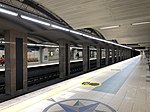Sacramento (Lisbon)
Former parishes of LisbonLisbon geography stubs
Sacramento is a former civil parish (freguesia) in the city and municipality of Lisbon, Portugal. It had a total area of 0.08 km2 and total population of 880 inhabitants (2001); density: 18,864.2 inhabitants/km2. At the administrative reorganization of Lisbon on 8 December 2012 it became part of the parish Santa Maria Maior.
Excerpt from the Wikipedia article Sacramento (Lisbon) (License: CC BY-SA 3.0, Authors).Sacramento (Lisbon)
Largo do Carmo, Lisbon Santa Maria Maior (Santa Maria Maior)
Geographical coordinates (GPS) Address Nearby Places Show on map
Geographical coordinates (GPS)
| Latitude | Longitude |
|---|---|
| N 38.7122222322 ° | E -9.14000001 ° |
Address
Igreja do Convento de Santa Maria do Carmo (Igreja do Convento do Carmo;Museu Arqueológico do Carmo;Ruínas do Carmo)
Largo do Carmo
1200-092 Lisbon, Santa Maria Maior (Santa Maria Maior)
Portugal
Open on Google Maps









